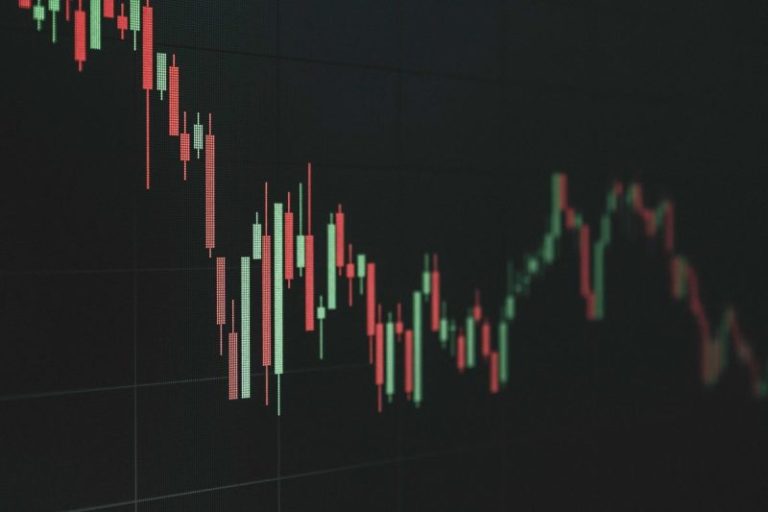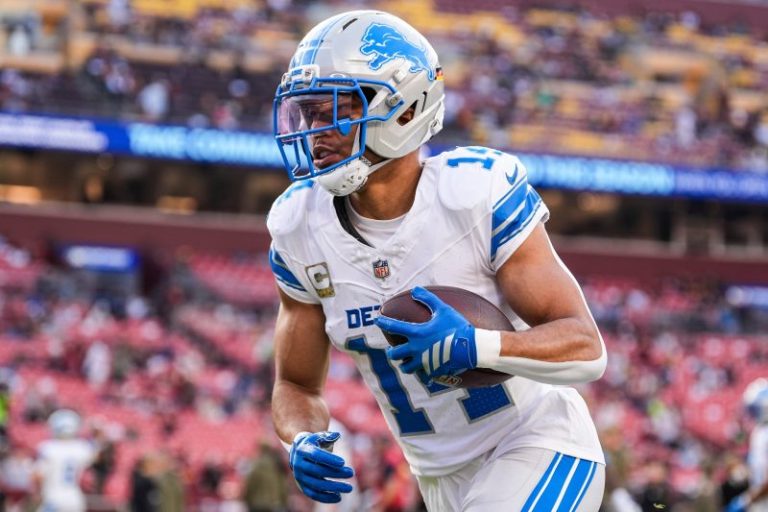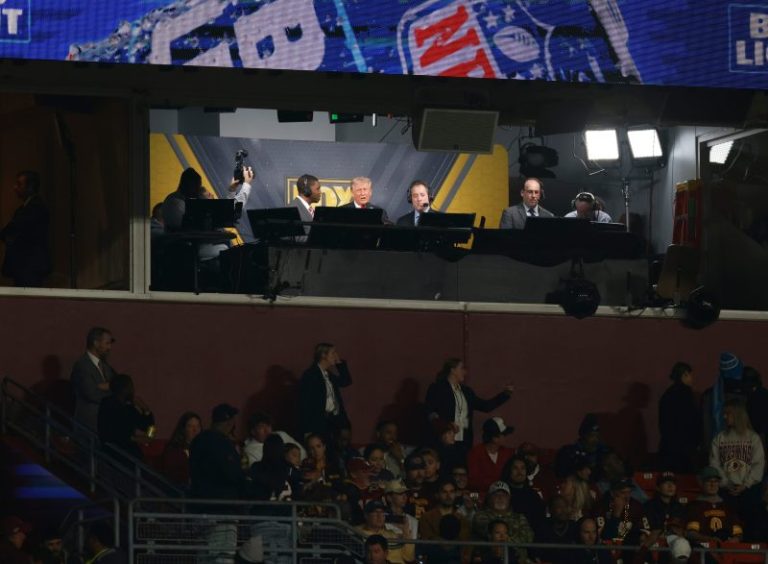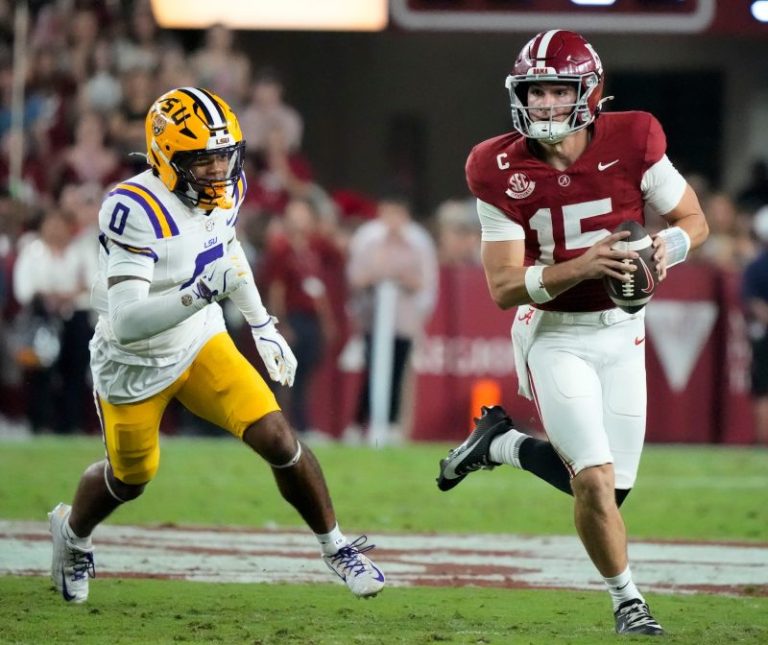Roll Tide Roll.
Thanks to a late fourth-quarter fumble caused by Yhonzae Pierre, No. 4 Alabama (No. 4 in College Football Playoff) continued to roll through the Southeastern Conference with a defensive 20-9 win over LSU on Saturday, Nov. 8 in Tuscaloosa, Alabama.
Stream Alabama vs. LSU football live with Fubo (free trial)
With its win, No. 4 Alabama has now won eight consecutive games, giving Kalen DeBoer’s a shot at making the SEC championship game and, potentially more.
A low-scoring game through the midway point of the second quarter, Alabama’s offense kicked it into high gear to end the first half, as the Crimson Tide scored two touchdowns in the final 9:25, including a 13-yard touchdown pass from Ty Simpson to Ryan Williams just before they went into the locker room.
LSU interim head coach Frank Wilson benched Garrett Nussiemer in the third quarter, replacing him with backup Michael Van Burden. The Tigers weren’t able to overcome numerous self-inflicted wounds on offense despite a stellar night from their defense.
Simpson struggled at times throughout the night, especially with the deep ball. The Heisman Trophy candidate completed 21 of 35 passes (60%) for 277 yards and a touchdown, but also lost a fumble on the first play of the fourth quarter.
The win for the Crimson Tide extends its nation leading home win streak to 17 straight, and its record at home under DeBoer to 12-0. USA TODAY Sports provided live updates, stats and highlights from the Crimson Tide Week 11 win over the Tigers. Follow below:
Alabama vs LSU football live score
This section will be updated during the game
Alabama vs LSU football updates
Final: Alabama 20, LSU 9
It wasn’t pretty, but Alabama slogged through a defensive-dominant game vs. LSU to emerge victorious, 20-9. The Crimson Tide return to Bryant-Denny Stadium in Week 12 to take on Oklahoma.
Alabama forces fumble
Yhonzae Pierre comes up with his second big play of the night, and this time it results in a turnover. The Alabama linebacker came around the side and knocked the ball out of the hand of Michael Van Buren for the fumble at the end of a sack, which was recovered by London Simmons.
Alabama takes over on offense.
Alabama extends lead with FG
Conor Talty redeems himself from an earlier miss in the game with a successful 44-yard field goal to push Alabama’s lead over LSU to a two-score game, at 20-9. Those are the first points for the Crimson Tide since Ty Simpson connected with Ryan Williams for a 13-yard touchdown just before halftime.
Alabama now leads LSU 20-9 with 4:25 remaining in the fourth quarter.
Alabama punts
Alabama has gone cold on offense, as Kalen DeBoer sends out the punt unit for the second time in the Crimson Tide’s last three drives. The Crimson Tide’s defense got some help from its special teams unit, however, as the ball is spotted at LSU’s own 2-yard line.
LSU cuts deficit to one score with FG
LSU is not going away that easily.
The Tigers make it a one-score game at 17-9 against Alabama with 10:28 remaining in the fourth quarter after Damon Ramos makes the 37-yard field goal attempt. LSU had made it all the way down to the Alabama 7-yard line, but a false start penalty and a 10-yard sack on Michael Van Buren sent the Tigers backwards.
An important drive is coming up for Ty Simpson and Alabama’s offense after Simpson turned the ball over on the first play of the fourth quarter.
Alabama sacks Michael Van Buren
LT Overton comes up with the second sack of the night for the Alabama defense on first-and-goal from the 12-yard line, as he sacks Michael Van Buren for a loss of 10 yards to make it second-and-goal from the Crimson Tide’s 22-yard line.
LSU sacks Ty Simpson, forces fumble
LSU opens the fourth quarter with its first takeaway on defense, as Harold Perkins sacks Ty Simpson and forces the ball out of the hands of the Alabama quarterback. The Tigers linebacker recovers his own forced fumble and gives the ball back to Michael Van Buren and the LSU offense deep in Alabama territory, down 17-6.
Alabama takes lead over LSU into fourth quarter
Fours up in Tuscaloosa, as Alabama takes a 17-6 lead over LSU into the fourth quarter. The Crimson Tide will start the fourth quarter with a second-and-9 at their own 48-yard line following a 1-yard carry from Daniel Hill.
Alabama is 15 minutes away from picking up its eighth consecutive win of the season. Ty Simpson is 17 of 28 passing for 244 yards and a touchdown, while Michael Van Buren is 2 of 4 for 16 yards since he came in for Garrett Nussmeier during LSU’s last drive.
End of third quarter: Alabama 17, LSU 6
LSU false start forces to punt
LSU’s communication struggles on offense continue on fourth-and-1, as offensive lineman Bauer Sharp jumps before the snap. The 5-yard penalty sends Michael Van Buren and the Tigers’ offense off the field, and sends a punt unit on.
It’s the second big communication error by the Tigers in as many plays, and kills a drive that showed a slight pulse from LSU’s offense after Garrett Nussmeier was benched.
Michael Van Buren takes over for Garrett Nussmeier
As the LSU offense heads back onto the field, the Tigers do so with a new quarterback, as backup quarterback Michael Van Buren is in for Garrett Nussmeier.
Alabama sacks Garrett Nussiemer, LSU hits FG attempt
Alabama dials the pressure on third-and-8 with the three-man rush to Garrett Nussmeier, who was sacked for a loss of 14 yards by Yhonzae Pierre. Nussmeier attempted to get away from the rush, but he turned in the wrong direction and into the diving hands of Pierre.
Nussiemer’s sack sends out the LSU field goal unit. The Tigers cut their deficit to 17-6 after Damian Ramos hit the 44-yard field goal attempt. LSU has yet to score a touchdown on the night.
Nic Anderson injury update
LSU will be down a man at wide receiver, as Nic Anderson is carted off the field after being tended to by LSU trainers on the sidelines. Anderson appeared to have gone down weirdly at the conclusion of a 16-yard catch when he was tackled by two Alabama defenders.
End of first half: Alabama 17, LSU 3
Alabama vs LSU halftime stats
Here’s a look at how Alabama and LSU stack up statistically at halftime, with the Crimson Tide holding a 17-3 lead:
- Total yards: Alabama 244, LSU 131
- Passing yards: Alabama 210, LSU 76
- Rushing yards: LSU 55, Alabama 34
- Yards per play: Alabama 7.4, LSU 4.9
- Third downs: Alabama 2-6, LSU 2-7
Alabama scores quick TD before halftime
Alabama offensive coordinator Ryan Grubb is in his bag.
One play after Ty Simpson connected with Lotzeir Brooks for a 53-yard catch on the deep route, the Heisman Trophy candidate finds Ryan Williams in the end zone for a 13-yard touchdown pass. It’s an impressive drive by Alabama, as Simpson threw back-to-back dots into the hands of his receivers to get points on the board before halftime.
The scoring drive was three plays for 66 yards and took just 34 seconds of game time.
Alabama misses field goal attempt
Alabama is unable to extend its lead over LSU to two scores, as Conor Talty’s 26-yard field goal attempt goes wide left. It’s an important series coming up for the Crimson Tide’s defense, as they will look to get a stop to keep their seven-point lead intact as LSU begins the second half with the ball.
Aaron Anderson injury report
ESPN’s Molly McGrath reports that LSU wide receiver Aaron Anderson hyperextended his left elbow on the Tigers’ previous offensive drive and that LSU’s medical staff has put a brace on his elbow. He is expected to return to the game.
Daniel Hill TD puts Alabama in front
The first touchdown of the night goes to Alabama and Daniel Hill, who fights his way through a group of LSU defenders to get into the end zone. It’s a 4-yard rushing touchdown for the sophomore running back, and his second rushing score of the season.
The big play of the drive was a 33-yard pass down the left side of the field on second-and-3 when Simpson found his tight end, Josh Cuevas, in stride. The scoring drive was seven plays for 75 yards and took 3:02 off the game clock.
It’s 10-3 Alabama with 9:25 remaining in the second quarter.
LSU ties game with 37-yard FG
Wilson elects to take the field goal out of the injury timeout on the field for Aaron Anderson. Damian Ramos hits the 37-yard field goal to tie the game at 3-3 against Alabama with 12:27 remaining in the second quarter.
Both teams have exchanged field goals in the first half, as both teams’ offenses continue to settle in.
LSU facing fourth down decision
LSU interim head coach Frank Wilson faces an early big decision: go for it on a fourth-and-2 at the Alabama 20-yard line or take the field goal. Before heading off the injury tent, Aaron Anderson caught a 7-yard pass from Garrett Nussiemer to make it fourth-and-short for the Tigers.
End of first quarter: Alabama 3, LSU 0
Alabama gets on board with field goal
Despite the good starting field position, Alabama goes backward, setting up a 45-yard field goal attempt from kicker Conor Talty. His kick is true, however, sailing through the middle to give the Crimson Tide the first points of the game.
Alabama forces turnover
What looked like a huge LSU chunk play on third-and-5 from the Tigers’ 11 instead turns into a turnover, courtesy of the Alabama defense. Linebacker Nikhai Hill-Green punched the ball out of tight end Bauer Sharp and recovers it deep in LSU territory.
Alabama punts
The Crimson Tide get a nice chunk play off a 33-yard connection between Ty Simpson and Germie Bernard out to the Alabama 39-yard line, but follow that up with three straight incompletions (including two throwaways) to end the drive. Following a 40-yard punt by Blake Doud, LSU will take over at its own 7-yard line.
LSU misses field goal attempt
Another bend-don’t-break effort by Alabama’s defense sets LSU up with a field goal attempt from the Crimson Tide 13-yard line. But Tigers kicker Damian Ramos, who entered the game 14 of 17 on field goal attempts, kicked it wide right to negate the scoring opportunity.
Alabama turns ball over on downs
Alabama tries to catch LSU off guard with a fake on fourth-and-1, as Jam Miller takes the direct snap, but LSU linebacker West Weeks is all over it and tackles Miller for no gain. It was an interesting play-calling sequence by the Crimson Tide, as they called three consecutive run plays.
LSU takes over at its own 39-yard line.
Alabama starts on offense
After LSU won the toss and deferred the opening kickoff to the second half, Alabama gets its night started on offense with a 25-yard kickoff return from Lotzeir Brooks. Underway in Tuscaloosa!
Pregame
Dave Roberts at Alabama-LSU game
World Series champion manager Dave Roberts is in attendance for Alabama vs. LSU in Tuscaloosa. According to The Tuscaloosa News’ Colin Gay, the Los Angeles Dodgers manager is friends with Alabama coach Kalen DeBoer.
Ryan Williams status vs LSU
Ryan Williams looks to be a go against LSU. The Crimson Tide sophomore was removed from the final SEC injury report, which was released 90 minutes before the game on Saturday, Nov. 8, after being listed as ‘probable’ on the previous three.
What was Alabama football ranked in first CFP ranking?
Who is LSU football’s interim head coach vs Alabama?
Ty Simpson Heisman Trophy odds
The first-year Alabama starting quarterback enters his Week 11 start vs. LSU with the third-best odds on BetMGM (+350) to win the 2025 Heisman Trophy.
What time does Alabama vs LSU start?
- Date: Saturday, Nov. 8
- Start time: 7:30 p.m. ET
Alabama vs. LSU will kick off at 7:30 p.m. ET on Saturday, Nov. 8 from Bryant-Denny Stadium in Tuscaloosa, Alabama.
What TV channel is Alabama vs LSU on today?
- TV: ABC
- Streaming: ESPN app | Fubo (free trial)
Alabama vs. LSU will be broadcast nationally on ABC in Week 11 of the 2025 college football season. Sean McDonough and Greg McElroy will broadcast the game from the booth at Bryant-Denny Stadium, with Molly McGrath reporting from the sidelines.
Streaming options for the game include the ESPN app (with a TV login) and Fubo, which carries ABC and offers a free trial to new subscribers.
Stream Alabama vs. LSU football live with Fubo (free trial)
How to watch college football on ESPN, ABC without YouTube TV
Disney-owned channels such as ABC and the ESPN family of networks are no longer available on YouTube TV after it and Disney were unable to agree to new contract terms.
One way college football fans who subscribe to YouTube TV can stream games on Disney-owned channels is via Fubo, which carries ABC and the ESPN family of networks and offers a free trial to potential subscribers.
Alabama vs LSU predictions
Colin Gay, The Tuscaloosa News: Alabama 32, LSU 21
‘Who knows what LSU could look like with interim coach Frank Wilson? With two weeks to prepare for Alabama, the Tigers could lead with one of the better pass offenses and pass defenses in the SEC. But, especially facing an Alabama pass rush that is finding its footing, and the best passing offense that it has faced all season, LSU has a tall task, one that should continue the Crimson Tide’s SEC success.’
Chase Goodbread, The Tuscaloosa News: Alabama 23, LSU 17
‘A lower-scoring affair could be in order. LSU QB Garrett Nussmeier has struggled to be effective behind an underperforming offensive line. A full house at Bryant-Denny Stadium won’t make it any easier for him. But it likely won’t be an easy night for Alabama’s offense, either.’
Alabama schedule 2025
Here’s a look at Alabama’s 2025 schedule, including past scores and available kickoff and TV channel information:
- Saturday, Aug. 30: Florida State 31, Alabama 17
- Saturday, Sept. 6: Alabama 73, ULM 0
- Saturday, Sept. 13: Alabama 38, Wisconsin 14
- Saturday, Sept. 20: BYE
- Saturday, Sept. 27: Alabama 24, No. 5 Georgia Tech
- Saturday, Oct. 4: Alabama 30, No. 16 Vanderbilt 14 *
- Saturday, Oct. 11: Alabama 27, No. 14 Missouri 24 *
- Saturday, Oct. 18: Alabama 37, No. 11 Tennessee 20 *
- Saturday, Oct. 25: Alabama 29, South Carolina 22 *
- Saturday, Nov. 1: BYE
- Saturday, Nov. 8: vs. LSU * | 7:30 p.m. | ABC (Fubo)
- Saturday, Nov. 15: vs. No. 12 Oklahoma * | 3:30 p.m. ET | ABC (Fubo)
- Saturday, Nov. 22: vs. Eastern Illinois | 2 p.m. ET | SEC Network+
- Saturday, Nov. 29: at Auburn *
* Denotes SEC game
LSU schedule 2025
Here’s a look at LSU’s 2025 schedule, including past scores and available kickoff and TV channel information:
- Saturday, Aug. 30: LSU 17, No. 4 Clemson 10
- Saturday, Sept. 6: LSU 23, Louisiana Tech 7
- Saturday, Sept. 13: LSU 20, Florida 10
- Saturday, Sept. 20: LSU 56, Southeastern Louisiana 10
- Saturday, Sept. 27: No. 13 Ole Miss 24, LSU 19 *
- Saturday, Oct. 4: BYE
- Saturday, Oct. 11: LSU 20, South Carolina 10 *
- Saturday, Oct. 18: No. 17 Vanderbilt 31, LSU 24 *
- Saturday, Oct. 25: No. 3 Texas A&M 49, LSU 25 *
- Saturday, Nov. 1: BYE
- Saturday, Nov. 8: at No. 4 Alabama * | 7:30 p.m. ET | ABC (Fubo)
- Saturday, Nov. 15: vs. Arkansas * | 12:45 p.m. ET | SEC Network (Fubo)
- Saturday, Nov. 22: vs. Western Kentucky
- Saturday, Nov. 29: at No. 12 Oklahoma *
* Denotes SEC game
This post appeared first on USA TODAY










